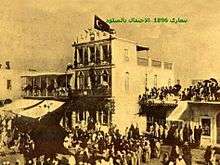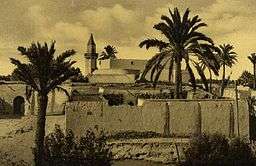Turks in Libya
| Total population | |
|---|---|
|
(Ottoman-Turkish descendants: 1,500,000 (2015 estimate[1][2]) 35,062 or 4.7% of Libya's population (1936 census[3])) | |
| Regions with significant populations | |
| Languages | |
| Religion | |
| Islam |
Turks in Libya, also known as Libyan Turks and Turco-Libyans, (Turkish: Libya Türkleri) are the ethnic Turks who live in Libya. During the Ottoman rule of Libya, the Turks colonized and dominated the political life of the region, as a result, the ethnic mix of Libya changed with the migration of Turks from Anatolia and the evolvement of the "Kouloughlis" (also referred to as "Cologhlis"[4]) who are people of mixed Turkish and Maghrebi blood.[5] There has also been a modern wave of migration since 1975 from Turkey.
History
Ottoman migration


When the Ottoman Empire conquered Libya in 1551 the Turks began migrating to the region, as a consequence, many Turkish soldiers married Arab women and their children were known as the "Kouloughlis" (also referred to as the "Cologhla", "Qulaughli" and "Cologhli").[6]
By 1936 the Turkish community formed 5% of Libya's population, numbering about 35,000,[3] of which 30,000 lived along the Tripolitanian coast.[6]
Today there are still Libyans who regard their ethnicity as Turkish, or acknowledge their descendants to the Turkish soldiers who settled in the area during the Ottoman rule.[7] Indeed, many families in Libya can trace their origins through their surnames. It is very common for families to have surnames that belgong to the region of Turkey that their ancestors migrated from; for example, Tokatlı, Eskişehirli, Muğlalı, and İzmirli are very common surnames.[1][2]
Modern migration
Turkish labour migration has traditionally been to European countries within the context of bilateral agreements.[8][9][10] In 2011 there were 25,000 Turkish citizens residing in Libya.[11]
| Emigration of Turkish workers to Libya[12] | |||||||
| Year | Population | ||||||
|---|---|---|---|---|---|---|---|
| 1961-1973 | 664 | ||||||
| 1974-1980 | 48,457 | ||||||
| 1981-1985 | 106,735 | ||||||
Demographics

There is a significant Turkish community living in the north-west of Libya. For example, many Turks settled in Misrata during the reign of Abdul Hamid II in the nineteenth century.[1][2]
The last census which allowed the Turkish minority to declare their ethnicity showed the following:
| Administrative division | Turks (1936 census)[13] | % Turkish[13] |
|---|---|---|
| Province of Misurata | 24,820 | 11.6% |
| Province of Tripoli | 5,848 | 1.7% |
| Libyan Sahara | 3,341 | 6.9% |
| Province of Derna | 730 | 1.8% |
| Province of Benghazi | 323 | 0.3% |
| Libya, Total | 35,062 | 4.7% |
Today the Turks form two-thirds (est.266,640) of Misrata's 400,000 inhabitants.[14] There is also a thriving Turkish population in Tripoli.[15]
Religion
The Ottoman Turks brought with them the teaching of the Hanafi School of Islam during the Ottoman rule of Libya which still survives among the Turkish descended families today. Examples of Ottoman-Turkish mosques include:

- Darghut Mosque
.jpg) Ahmed Pasha Karamanli Mosque
Ahmed Pasha Karamanli Mosque
Associations and Organisations
Since 2011 the Türk-Libya İşbirliği (The Turkish-Libyan Cooperation) has been active. By 2015 the Libyan Turks also formed the "Libya Köroğlu Derneği" (The Libyan Kouloughlis Association), with the aim of bringing greater awareness of the existence of the Turkish minority and promoting their culture in both Libya and Turkey.[1][2]
Notable people
- Shaha Riza
- Ahmed Karamanli, founded the Karamanli dynasty
- Yusuf Karamanli
- Sadullah Koloğlu, former prime minister of Benghazi and Darnah (from 1949 to 1952)[16]
See also
References
- 1 2 3 4 Kutlugün, Satuk Buğra (2015). "Osmanlı torunları Libya'da dernek kurdu". Bugun. Retrieved 2016-05-15.
- 1 2 3 4 Kutlugün, Satuk Buğra (2015). "Osmanlı torunları Libya'da dernek kurdu". Anadolu Agency. Retrieved 2016-05-15.
- 1 2 Pan 1949, 103.
- ↑ Ahmida 2009, 23.
- ↑ Stone 1997, 29.
- 1 2 Dupree 1958, 41.
- ↑ Malcolm & Losleben 2004, 62.
- ↑ Sirageldin 2003, 236
- ↑ Papademetriou & Martin 1991, 123
- ↑ Ergener 2002, 76
- ↑ Turkish Weekly. "Turkey Struggles with Chaotic Evacuation of Citizens from Libya". Retrieved 2011-02-22.
- ↑ Papademetriou & Martin 1991, 120.
- 1 2 Pan 1949, 121.
- ↑ Muradoğlu, Abdullah (2015). "Kuloğlu'nun ahvâlini sorana..". Yeni Şafak. Retrieved 2016-05-15.
- ↑ Hasasu, Can (2014). "Kod adı Şakir". Aljazeera. Retrieved 2016-05-16.
- ↑ Hurriyet Daily News. "Turkey's living link to Ottoman Libya: Son of former PM tells father's story". Retrieved 2016-05-15.
Bibliography
- Ahmida, Ali Abdullatif (2009), The Making of Modern Libya: State Formation, Colonization, and Resistance (Print), Albany, N.Y: SUNY Press, ISBN 1-4384-2891-X.
- Dupree, Louis (1958), "The Non-Arab Ethnic Groups of Libya", Middle East Journal, 12 (1): 33–44
- Ergener, Reşit (2002), About Turkey: Geography, Economy, Politics, Religion, and Culture, Pilgrims Process, ISBN 0-9710609-6-7.
- Fuller, Graham E. (2008), The New Turkish Republic: Turkey as a pivotal state in the Muslim world, US Institute of Peace Press, ISBN 1-60127-019-4.
- Harzig, Christiane; Juteau, Danielle; Schmitt, Irina (2006), The Social Construction of Diversity: Recasting the Master Narrative of Industrial Nations, Berghahn Books, ISBN 1-57181-376-4.
- Koloğlu, Orhan (2007), 500 Years in Turkish-Libyan Relations (PDF), SAM.
- Malcolm, Peter; Losleben, Elizabeth (2004), Libya, Marshall Cavendish, ISBN 0-7614-1702-8.
- Pan, Chia-Lin (1949), "The Population of Libya", Population Studies, 3 (1): 100–125, doi:10.1080/00324728.1949.10416359
- Papademetriou, Demetrios G.; Martin, Philip L. (1991), The Unsettled Relationship: Labor Migration and Economic Development, Greenwood Publishing Group, ISBN 0-313-25463-X.
- Sirageldin, Ismail Abdel-Hamid (2003), Human Capital: Population Economics in the Middle East, American University in Cairo Press, ISBN 977-424-711-6.
- Stone, Martin (1997), The Agony of Algeria, C. Hurst & Co. Publishers, ISBN 1-85065-177-9.
